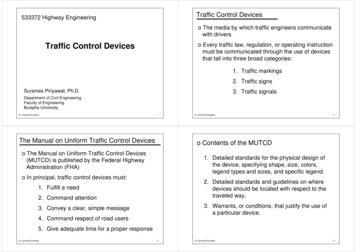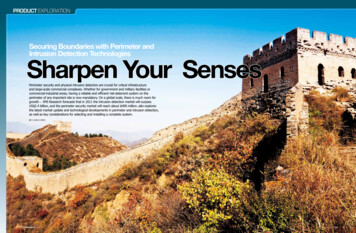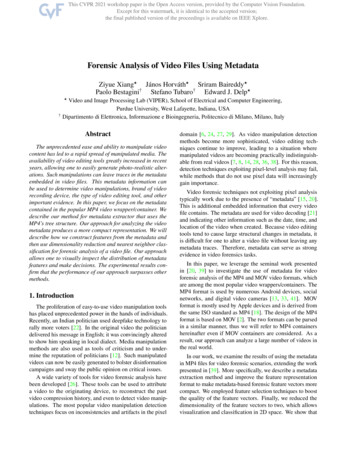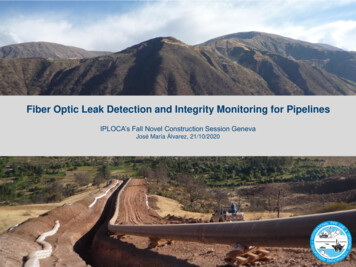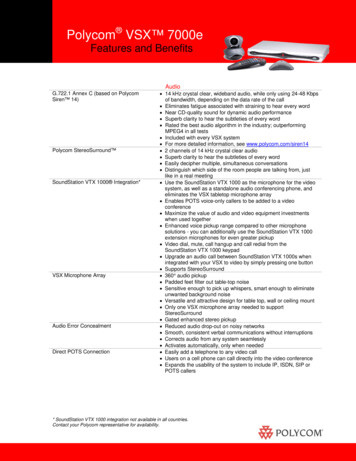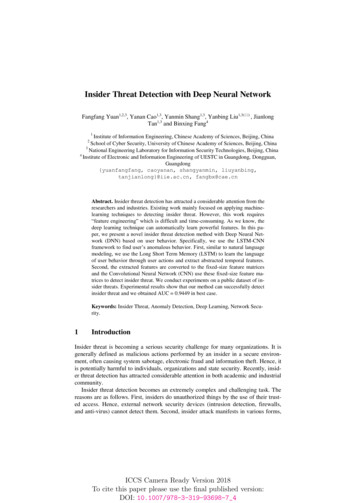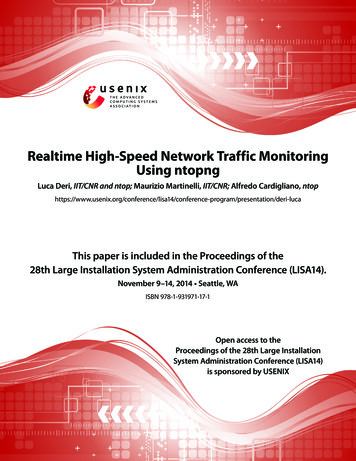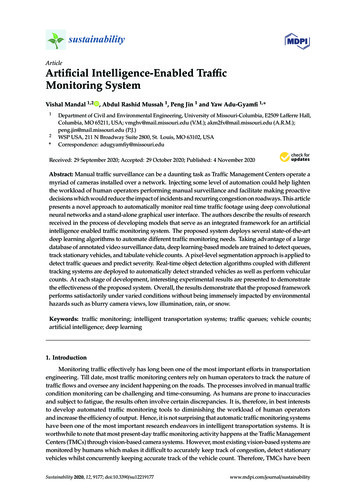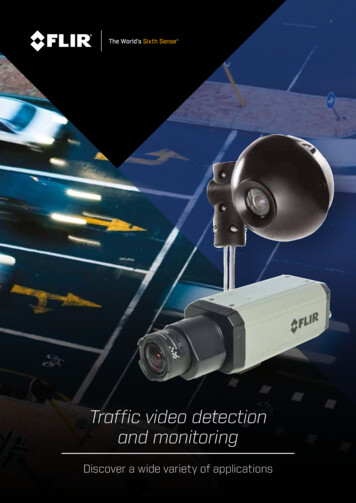
Transcription
Traffic video detectionand monitoringDiscover a wide variety of applications
Table of contents1.FLIR for Smart Traffic Management. page 42.Safety and efficiency in any trafficenvironment. page 63.Proven technology, proven results. page 84.5 reasons to choose FLIR for yourtraffic project. page 125.Don't take it from us. page 136.A FLIR solution for every traffic andtransportation need. page 447.Thermal imaging: a wide varietyof applications. page 488.Send us your application. page 52The images displayed may not be representative of the actual resolution of the camerashown. Images for illustrative purposes only.3
1FLIR for Smart Traffic ManagementFLIR: The World’s Sixth SenseFLIR Systems, Inc. designs, develops, manufactures, markets, anddistributes technologies that enhance perception and awareness. Webring innovative sensing solutions into daily life through our thermalimaging systems, visible-light imaging systems, locator systems,measurement and diagnostic systems, and advanced threat detectionsystems. Our products improve the way people interact with the worldaround them, enhance public safety and well-being, increase energyefficiency, and enable healthy and entertained communities.4
FLIR Intelligent Transportation SystemsWith roads getting more crowded and cities more congested, there isan increasing need to monitor traffic in a smart way. Traffic managementoperators want solutions that allow them to better manage intersections,make it safer for vulnerable road users to participate in traffic, to preventsecondary accidents on roads and in tunnels, or to gather insights fromtheir traffic. FLIR Intelligent Transportation Systems, FLIR’s dedicatedbusiness unit for ITS, focusses entirely on these needs.FLIR Intelligent Transportation Systems has grown out of the acquiredcompany Traficon International, a major player in the traffic marketfor more than 25 years. Today, FLIR ITS uses a combination of visualcameras, thermal imaging cameras, smart video analytics, and trafficmanagement software to support traffic operators in making roads saferand traffic flows smoother.5
2Safety and efficiency in any traffic environmentUrban areasFLIR’s traffic sensors help you controltraffic lights at intersections, so yoururban traffic can flow smoothly. Inaddition, they help optimize trafficflows for pedestrians and bicyclistsand improve their safety in busy trafficscenes.HighwaysFLIR detection technology helps avoidincidents and traffic jams on highways.Early detection of road irregularitiesenables rescue teams to intervene fastand avoid secondary accidents.TunnelsFLIR’s incident detection solutions helpsave lives in tunnels and avoid secondaryaccidents, by detecting smoke, lostcargo, pedestrians and many othertraffic events very fast.Railway tracks and platformsFLIR’s thermal imaging cameras preventserious accidents and infrastructuredamage by detecting vehicles thathave stopped on railway tracks at levelcrossings. FLIR’s thermal camerasalso detect people on train/metro/tramtracks and platforms in an early stage,so accidents can be avoided.’Intersection controlFLIR’s video and thermal sensors are a reliablealternative to loops and other detection technologies.By detecting vehicles, bicyclists and pedestrians,FLIR’s sensors enable smart intersection control toimprove city traffic flows and enhance safety for allroad users.Pedestrian safety and mobilityBy detecting people on a crosswalk or on thesidewalk, FLIR’s pedestrian sensors allow you tocontrol your traffic lights in favor of pedestrians ormake pedestrians more visible in traffic.Highway monitoringFLIR’s thermal imaging cameras help keep an eyeon our highways. Because they don’t have problemswith darkness, shadows, or too much light, theyoffer a true 24/7 solution for highway operators.
Automatic Incident Detection (AID)FLIR’s detection solutions allow you to detect stoppedvehicles, wrong-way drivers, queues, slow-movingvehicles, fallen object or pedestrians in a matter ofseconds, so you can prevent secondary accidents.Data collection & flow monitoringFLIR’s cameras and sensors accurately monitortraffic flows and help you to keep highways safe.Other applications include queue monitoring duringroad works and travel time calculation based on flowinformation.Fire detection in tunnelsFLIR thermal imaging cameras allow tunnel operatorsto monitor traffic flows and detect incidents or fires inan early stage. Firefighters also use thermal camerasto enhance their vision and to see through smoke ordetect hot spots.Vehicle detection at railway crossingsFLIR thermal cameras can detect stationary vehicleson the tracks at level crossings and as a result preventheavy collisions. This way, train or tram operators canbe warned for oncoming danger or warning lights canbe activated.Trackside monitoringFLIR thermal cameras can detect people on metro,tram or railway tracks. Whether a person just fell fromthe platform or is deliberately walking on the tracks,FLIR cameras ensure 24/7 detection on tracks or intunnels.Driver vision enhancementFLIR’s thermal imaging night vision systems installedonboard trams allow drivers to see clearly in totaldarkness or in bad weather conditions, offeringincreased detection of potential hazards, likepedestrians, cars, animals, on the tracks.7
3Proven technology, proven resultsFLIR Intelligent Transportation Systems offers both the hardware and softwarefor intelligent traffic detection and monitoring. The combination of a videocamera or thermal imaging camera with intelligent video analytics providestraffic managers worldwide with a perfect solution for managing and monitoringtraffic streams.Smart video analyticsAn installed video or thermal imaging camera sends an input signal to adetection unit. This unit can either be on board of the camera or integratedinto a standard 19-inch rack. When the camera or the video image processingmodules are set, detection zones are superimposed onto the video image. Whena vehicle, bicycle or pedestrian enters a detection zone, detection is activated bythe system. Dedicated algorithms generate various types of traffic information:presence and incident-related data, data for statistical processing, and data forpre- and post-incident analysis.Stopped vehicle detection on visiblelight video imageBicycle detection on a thermalcameraPedestrian detection on a thermalcameraTraffic data, compressed images and alarms are transmitted to the technicalcontrol room. The detection can trigger a third party system such as a trafficlight, electronic traffic sign or any other VMS panel. When an alarm is generated,the traffic manager in the control room will receive a visual image of the scene,so appropriate actions can be taken.VMS PanelsATTENTIONTunnel accessTraffic lightsDetectDetect & analyze(integrated)8ANALYZEManage
Thermal imagingTraditionally, CCTV cameras are being used for video monitoring. Althoughthese are reliable tools for video analysis, they need additional algorithmsto overcome the limitations of traditional video cameras, such as sun glareor darkness. Thermal imaging cameras do not have these issues. A thermalimaging camera creates a crisp image based on subtle temperature differences.They do not need any light whatsoever. They are also not blinded by directsunlight. FLIR's high-performance thermal imaging cameras give you uninter rupted 24-hour detection of vehicles, pedestrians and cyclists, regardless of theamount of light available.Sun glareGlare from the sun blindsconventional video cameras,effectively hiding vehicles,people, and animals. Thermalcameras ignore this glare,and only respond to the heatsignatures they detect.HeadlightsHeadlights are confusing toCCTV cameras. This causesfalse and missed calls andmakes accurate observationof highway traffic at nightimpossible. Thermal cameras are immune to headlightglare, so they see clearly.See through shadowsVideo cameras can miss pedestrians, cyclists, animals,and even cars if they’re in theshadows. But since thermalcameras see heat, not light,there are no shadows in athermal world.Long-range night viewingAt night, a highway looks like anindistinct row of lights to a video camera, making meaningfuldata collection and incident assessment impossible. But thermal cameras see the heat signatures of vehicles clearly frommiles away. They also provideclear video of the roadsides forawareness of parked vehiclesor other VISIBLETHERMAL9
Wi-Fi trackingFLIR’s latest urban traffic sensors have optional Wi-Fi tracking technology thatcan be used to capture traffic flow data. By monitoring Wi-Fi Mac addressesof Wi-Fi enabled devices such as smartphones, these sensors can determinetravel & route times along road segments. Via Wi-Fi signal strength information,they can also measure queue delay times at intersections. With Wi-Fi detection,vehicle movement is fully characterized as a vehicle approaches, stopsand leaves an intersection. By matching MAC addresses across differentintersections, travel times are calculated in real-time.Counts, occupancy,travel time,intersection delay,priority vehicles001001010100100110100111010010 00100100101010The information from different sensors can be collected, combined and accessedfor further traffic analysis by FLIR’s cloud-base analysis platform. Smart analyticstransform the data into useful traffic insights, critical to understand the roadnetwork performance.Hybrid camerasFor specific traffic situations, a combination of different detection technologiesdelivers optimal results.For example, FLIR uses a combination of visible-light video with radar in orderto detect the presence of vehicles approaching or waiting at an intersection.FLIR’s hybrid video/radar detector will warn the traffic light controller whenevera vehicle is present in the dilemma zone, either extending green time orby extending all red lights in order to improve overall safety at signalizedintersections.Another example is FLIR’s pan-tilt camera, which combines a thermal and avisual camera in one unit in order to monitor traffic clearly in total darkness,in bad weather and over a long range. Combined with FLIR’s video detectionanalytics, it offers an advanced incident detection and data collection system.10
11
45 reasons to choose FLIR for your traffic projectWhether you are monitoring traffic in an urban area, on highways orin tunnels, FLIR Systems offers a solution to ensure and safe smoothtraffic.1. Analyze traffic as it happens.The video or thermal images of FLIR cameras are analyzed in real time. Thisway, more efficient traffic management in tunnels, on highways and in urbanareas becomes a reality. Traffic lights can be adapted in real time according tothe current traffic flow. And in case of incidents, early detection enables fastintervention of rescue teams and prevents secondary accidents.2. Get immediate visual feedback.The combination of numerical data and a visual image sets video detection apartfrom all other detection systems. The immediate visual feedback received froma video detection system allows the traffic manager to assess what is happeningand to take appropriate action.3. Save on installation and maintenance.Video detection systems for monitoring traffic streams are very cost-efficient.Installation costs are low. All cameras can be easily installed on existingstructures like traffic lights or on other existing poles.4. Avoid missed and false calls.FLIR video detection and monitoring systems are used all over the globe. Trafficmanagers appreciate their high incident detection rate and high detection speed.Moreover, the incidents are detected very fast. This is translated into a low MeanTime to Detect (MTTD) and a low False Alarm Rate (FAR).5. Work with the world leader.Traffic managers worldwide have embraced the technology from FLIR formanaging traffic streams. More than 150,000 video detectors are operationalworldwide in over 70 countries. FLIR ITS has Automatic Incident Detection (AID)installations in more than 1,000 tunnels. More than 750 kilometers of tunnels arecontinuously being monitored by our systems. FLIR ITS solutions are being usedfor traffic light management at more than 30,000 intersections worldwide.12
5Don’t take it from us From large national traffic agencies to small city municipalities; all overthe world traffic authorities are using traffic detection and monitoringsolutions from FLIR Intelligent Transportation Systems to improve safetyand reduce congestion.On the following pages, we are presenting a selection of customerstories, where the use of visual and thermal imaging detection camerashas resulted in a significant improvement of traffic. Don’t take from us;just read what our customers have to say.13
City of Liverpool relies on thermal imagingto boost cyclingThe city of Liverpool wants to encourage people to leave the car athome more often and go cycling instead. In order to make that happen,the streets of Liverpool need to become a lot safer for cyclists. Thermaltraffic sensors from FLIR already give cyclists a head start on two busyintersections.FLIR distinguishes cyclists from other vehicles.This makes smart intersection control possible.Cllr Malcolm Kennedy,Liverpool City Council: Thanksto the FLIR sensors, cyclistshave more space and time tocross the six lanes of LeedsStreet, given their head start.This will give cyclists moreconfidence.FLIR only activates the dedicated bike signalscheme when a cyclist is arriving at the intersection.14A traffic signal, powered by FLIR displays agreen bike ‘on’ before the full green for othertraffic, allowing cyclists a five second headstart.
Smart traffic management in Darmstadt,GermanyIn order to make intelligent traffic management possible and make trafficflows smoother, traffic authorities of the city of Darmstadt, Germany haveinstalled more than 200 FLIR video detectors. The city also makes useof FLIR’s video management system which visualizes the traffic streamscoming from a wide variety of cameras.Darmstadt uses various types of video sensorsfor vehicle, pedestrian and bike detection.Marko Mitsch, e-netz SüdhessenGmbH & Co: “FLIR has shown usthe best approach over the years.With its video managementsystem and the integration ofmany elements that are specificto the city of Darmstadt, FLIRclearly differentiates itself fromcompetitors.”Darmstadt monitors road junctions from thetraffic control room without having to be present on location.All video streams and data generated by thevideo detectors, are collected by FLIR’s videomanagement software platform.With FLIR thermal sensors, the city of Darmstadt can detect bicyclists with high reliability.FLIR’s video management software managesand controls all traffic information and makes itmeaningful to the control room operator.15
FLIR enables smooth intersection traffic inUtrecht, the NetherlandsThermal sensors from FLIR have been deployed at a big signalizedintersection leading from Utrecht to Amersfoort, the Netherlands. Thesensors can distinguish between bicyclists and cars and thus enable aseparate signal scheme for bicyclists and motorists, all the while bothroad users are sharing the same road space.FLIR thermal sensors are an ideal solution for amixed traffic situation.Vehicle-only detection: FLIR offers a very interesting alternative for detection loops.Guus Sluijsmans, ImtechTraffic & Infra: “FLIR thermalsensors are the only solutionI know that can efficientlymake a distinction betweenbicyclists and motorists on thesame traffic lane.”FLIR sensors pick up heat energy coming fromthe cyclists and motorists and use this to makea distinction between the two.MotoristsonlyBicyclists onlyFLIR ThermiCamThe FLIR sensor transmits its detection information to the traffic light controller and enablesa more dynamic traffic light control.16For the specific situation at the Utrecht intersection, a separate regulation for bicyclists andmotorists was the best solution.
Lower Hutt, New Zealand, calls on FLIR toimprove pedestrian safetyPedestrian user-friendly intelligent (PUFFIN) crossings are a safe andefficient solution for pedestrians and motorists. With intelligent FLIRsensors controlling the traffic lights, pedestrians get exactly the timethey need to make it across. At the same time, PUFFIN crossings reduceunnecessary delays, so motorists benefit as well.As soon as a pedestrian enters a predefined detection zone, the software lengthens the green timefor the pedestrian and delays the green time for vehicles.FLIR sensors make use of predefined detectionzones, that are activated when entered.Wayne King, Hutt CityCouncil: “No other sensorsperform as well as FLIR’spedestrian and vehiclesensors. I would not want tohave it any other way.”On both sides of the crossing, the systemutilizes FLIR sensors, detecting pedestrianswaiting on the curbside pedestrians on theactual crossing.17
FLIR improves bicycle safety at TamakiDrive, Auckland, New-ZealandThe busy Tamaki Drive in Auckland, New Zealand, is a challenging mixedtraffic environment that has already witnessed several cycle incidents overthe past few years. To prevent incidents, Auckland Transport Authoritiesdecided on the integration of a bicycle warning system, activated by FLIRthermal imaging cameras.FLIR gives traffic managers uninterrupted, 24-hour detection of cyclists regardless of the amount oflight available and regardless of whether cyclists use the bike lane or main vehicle lane.Karen Hay, AucklandTransport: “The detectionof bicycles is very fast andvery accurate, regardless ofwhether we are looking at acarbon fiber bike or not.”Continuously flashing warning signals havea reduced effect. Detection-based warningsignals are much more effective.18
FLIR-powered intelligent crossing leads tomore safety for pedestriansA pedestrian safety system has been installed at a busy retail park nearGiltbrook, Nottingham, UK. The system uses flashing road studs andwarning signs, activated by FLIR pedestrian sensors, to create a visualwarning for motorists approaching an internal pedestrian crossing, whichspans the main vehicle access to the park.Detection of crossing pedestrians activates theroad studs and slowdown sign further up theroad.Configuration of the FLIR pedestrian sensoris done via portable PC with pre-installeduser-friendly software.The road studs only blink when pedestrians areusing the crossing.The system looks particularly good when it’sdark.“The FLIR sensors cansimply be mounted onexisting infrastructure andconfiguration of the sensorcan be done in less thanfive minutes.”The pole-mounted FLIR is the centerpiece ofthe installation.19
FLIR vehicle presence sensorsfor Lima city streetsThe city of Lima, Peru, is taking extensive measures to tackle its problemof heavy traffic congestion and pollution. As part of the solution, Lima cityauthorities recently called upon FLIR Intelligent Transportation Systemsto help them improve urban traffic flows. FLIR vehicle presence sensorshelp streamline traffic at 218 road intersections and help monitor vehicledensity, determine the peaks and throughs in the day’s traffic, andregulate the traffic lights’ green waves.“Lima’s traffic light network,including 218 roadintersections, now featuresFLIR video detectionsensors.”Heavy traffic in the streets of Lima in Peru.FLIR vehicle presence sensors monitor intersections and feed their video data back to the city’straffic control center.20
Video detection for intersectionmanagement in Salalah, OmanTogether with Oman engineering company Hi-Tech Projects LLC, FLIRrealized the country’s first video detection project ever. Always lookinginto modern and innovative solutions for their clients, Hi-Tech ProjectsLLC were convinced that it was time to make use of video detectiontechnology instead of inductive loops, which were the only detectionequipment used in Oman so far.Integration of video detection systems in thecity of Salalah, Oman.FLIR vehicle presence sensor“Our video detection solution had to be capable of operatingin harsh weather conditions, to be cost-effective and provideall necessary features for modern and effective trafficmanagement. FLIR’s vehicle presence sensor was up to thechallenge.” Ivan Krusic, Traffic Engineering & ITS Manager, HiTech Projects.FLIR vehicle presence sensors proved to be an excellent alternative to inductive loops, as Oman’sextremely hot weather conditions often lead to damaged asphalt, which in turn results in costlyroad works and re-installation of loops.21
Incident detection for the YamunaExpressway, IndiaThe Yamuna Expressway, leading from New Delhi to Agra over a165-kilometer stretch of concrete, features an all-inclusive trafficmanagement system, commissioned by transportation specialist Efkon,and advanced automatic incident detection technology from FLIRIntelligent Transportation Systems.By informing motorists and road authorities about possible incidents in time, secondary accidentscan be avoided.The control room of theYamuna Expressway.The Yamuna Expressway in New Delhi stretchesover 165 kilometer22“Thanks to FLIR ITS, theYamuna Expressway will notonly provide commuters witha smooth journey, but alsoa safe one. Traffic camerasequipped with the FLIR ITSincident detection system aremonitoring the expresswayfor accidents or anyirregularity that might occur,”Jeevit Vashishtha, BusinessDevelopment Manager, FLIRIntelligent TransportationSystems, India.
Kunshan City, China, relies on FLIR sensorsto keep the traffic flowing.Kunshan city authorities are now relying on FLIR’s vehicle presencesensor. In this project, 219 vehicle presence units have been installed tocollect traffic data of incoming vehicles at intersections.Covering three to four lanes,the FLIR sensors have beeninstalled at existing roadinfrastructures, such as roadsigns, road lighting poles,and traffic light poles.Kunshan relies on FLIR vehicle presence sensors to keep the traffic flowing.Thanks to FLIR ITS vehicle presence sensors, a smooth traffic flow is assured.FLIR’s vehicle presence sensors can be mounted easily on existing infrastructure.23
Watching over traffic streams in theEkeberg tunnel in Oslo, NorwayFor more than 15 years now, FLIR ITS video detection technology hasbeen watching over traffic streams in the Ekeberg tunnel in Oslo, Norway.When a bus coach caught fire inside the 1,500 m long tunnel in 1996, theEkeberg tunnel video detection system generated an alarm and the tunneloperators and emergency services were warned in a matter of seconds.The Ekeberg tunnel fire in 1996 put FLIR ITS video detection technology to the test.“The FLIR ITS system has proved to be very stable over thepast 15 years of operation. The great advantage of video detectionover other technologies is that the operator has an immediatevisual verification of the occurred incident.” Åge Reiakvam,section manager at Siemens Intelligent Traffic Systems.24
Monitoring the Middle East’sLongest TunnelThe overall goal of the Sheikh Zayed Tunnel (Abu Dhabi, UAE) is to reducecongestion. FLIR delivered 174 advanced network video encoders withintegrated Automatic Incident Detection capabilities for the Video IncidentDetection System (VIDS) component of the project. For the trafficmanagement component, known as the Video Vehicle Detection System(VVDS), FLIR delivered 45 network video encoders.Spanning 3.6km in total, including a 2.4km covered section, the Sheikh Zayed Tunnel is the MiddleEast’s longest road tunnel.A view inside the Sheikh Zayed Tunnel in Abu Dhabi, UAE.For the Sheikh Zayed Tunnel, FLIR was tasked with providingtechnology both for incident detection and traffic management.25
Traffic light control in Jakarta,IndonesiaIn order to tackle traffic congestion, Jakarta authorities laid out an ambitiousand very comprehensive master plan. As part of this set of measures anArea Traffic Control System (ATCS) was implemented. As a result trafficflows are improved and risk of congestion reduced. Today, more than 160vehicle presence sensors have been installed at some 37 intersectionsacross the city of Jakarta.FLIR sensors help meet Indonesia’s ambitious traffic management plans.When there is a traffic jam ata certain intersection, FLIRsensors can feed the ATCSsystem with vehicle presenceinformation and allow it todirectly alter the frequencyand duration of red and greenlights at that intersection.The Jakarta traffic control room.FLIR ITS sensors installed in Jakarta.26
New Tyne Crossing (UK) engages latestvideo detection technologyThe New Tyne Crossing project is one of the biggest transportinfrastructure projects currently active in Great Britain. The tunnel hasbeen designed for a daily traffic throughput of 24,000 vehicles and iscurrently serving 38,000 customers a day during peak periods. Currently83 video detection modules analyze the IP video streams to alertoperators if something goes wrong inside the tunnel.A view inside the New Tyne Crossing tunnel,one of the most prestigious UK transportationprojects.The New Tyne Crossing is a prestigious UKproject to develop a second vehicle tunnel under the River Tyne and to refurbish the existingvehicle tunnel.The New Tyne Crossing control room is one ofthe most modern control rooms in the UK.Entrance of the New Tyne Crossing tunnel.The integration of FLIR ITS technology is a huge step forwardin making the Tyne tunnels the safest in the UK.27
Smart intersection control in Mumbai andChennai, India.The cities of Mumbai and Chennai are investing heavily in advancedtechnologies and intelligent solutions that optimize traffic management.Nearly 700 vehicle presence detectors have been installed in the city ofMumbai. In Chennai, 100 vehicle presence detectors are installed andoperational.Installation of a FLIR vehicle presence sensor.Based on the informationcoming from FLIR vehiclepresence sensors, the city’straffic management systemalters traffic signal cyclesin real time to respond tochanging traffic conditions.FLIR sensors are used as part of the AreaTraffic Control (ATC) project to ensure that thetraffic flows safer and smoother.28
Vehicle presence detection on the SamuelBeckett Bridge (Dublin, Ireland)The Samuel Beckett Bridge in Dublin (Ireland) is a cable-stayed bridge,with a total length of 120 meters. The bridge has been designed on amassive pivot, which allows it to open through an angle of 90 degrees,allowing ships to pass through. To ensure that there are no vehicleson the bridge before opening it to ships, Dublin City Council installedmultiple vehicle presence sensors from FLIR.FLIR vehicle presence sensors are a cost-effective and reliable alternative for traditional inductiveloops.Via detection zones (virtual loops) and detection outputs,vehicle presence information is transmitted to the controller.When FLIR is not detecting any vehicle on the bridge,the controller can instruct safely to open the bridge.29
Passive detection provides activepedestrian safety in Maryland, USAThe Department of Public Works & Transportation (DPW&T) of PrinceGeorges County (Maryland, USA) is using FLIR pedestrian presencedetectors to increase safety at a busy midblock crossing. The sensors wereinstalled by Control Technologies (Florida, USA). The purpose of the FLIRsensors is to detect every person as they approach the crosswalk fromeither side, without requiring them to push a button.Video detection technology is passive – no action is required by the pedestrian – and this wasdesired because the pedestrians were simply not using the ‘push-button’.FLIR sensor installed at the top of the traffic lights.“Set-up and operationare a snap with the theFLIR pedestrian detectionsystem.” Jim Rhine, DPW&TPedestrians can cross safely thanks to the FLIR sensor.30
Smooth traffic between Denmark andSwedenAs a link between Copenhagen (Denmark) and Malmö (Sweden), the16.4 km Öresund bridge-tunnel is one of the longest in Europe. FLIRtechnology provides Automatic Incident Detection with more than180 cameras. Stopped vehicles, queues and wrong-way drivers areseamlessly detected.The Öresund bridge-tunnelfeatures a fully redundant videodetection system. The system willstill be operational in the event of acomponent failure (such as powerfailure, network communicationfailure, and so on), by havingback-up components that performduplicate functions.Video detection is key in keeping traffic runsmoothly.The 16.4 km Öresund bridge-tunnel is one of the longest in Europe.31
Real-time traffic updates for SingaporeroadsSingaporean transport authorities are increasingly coping with congestionand road safety issues. The country is a vast urban area and thus a perfectfit for FLIR’s urban vehicle detection technologies, designed to enhancesafety and alleviate congestion. 350 video image processing boardsinstalled along Singapore’s arterial roads help provide motorists with realtime information on traffic conditions.FLIR vehicle detection boards are feeding the Expressway Monitoring and Advisory System(EMAS) along Singaporean arterial roads.“The FLIR detection technology has proven to be performingextremely well in the difficult Singaporean conditions. Canopyshadows and tropical weather conditions: our detectors handleit very well.” Koen Soenens, International Business DevelopmentManager, FLIR Intelligent Transportation Systems.FLIR ITS processing boards help to ensure the smooth flow of traffic in Singapore.32
Enhanced pedestrian safety for Auckland,New ZealandFLIR’s pedestrian presence sensors are the preferred solution to helpenhance safety of vulnerable road users in Auckland, New Ze
By monitoring Wi-Fi Mac addresses of Wi-Fi enabled devices such as smartphones, these sensors can determine travel & route times along road segments. Via Wi-Fi signal strength information, . for further traffic analysis by FLIR's cloud-base analysis platform. Smart analytics transform the data into useful traffic insights, critical to .

